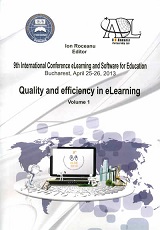AN ARCHITECTURE FOR THE INTEGRATION OF POWERPOINT AND VISUAL E-LEARNING TOOLS FOR ENGINEERING STUDENTS
AN ARCHITECTURE FOR THE INTEGRATION OF POWERPOINT AND VISUAL E-LEARNING TOOLS FOR ENGINEERING STUDENTS
Author(s): Georgiana ChişiuSubject(s): Education
Published by: Carol I National Defence University Publishing House
Keywords: visual literacy; visual materials
Summary/Abstract: Visual literacy is most of the time limited to an information transmission mode. This research paper underlines that this is an extremely restricted pedagogical use. Visual literacy is also most of the time confused with Power Point, which is indeed a very powerful and flexible teaching and learning tool. Nonetheless, we aim to complete this perspective by offering a complex framework of visual literacy practices. Besides offering a set of good practices in using visual materials with engineering students, we have engaged the effects of Power Point and Visual delivery systems. This quasiexperimental exploratory study examined the effect of Power Point and visual intervention in teaching presence and social presence on engineering students. In this research, we test whether using Visual materials in an engineering course enhances student short-term memory, long-term memory, and attitudes toward class presentation and the instructor. The experiment worked with two groups of participants. The group called "D" was engaged in a course that did not use visual materials, such as Power Point. Feed-back was provided after each course and at the end of the term. The second group involved in the experiment was called "DD". Power Point and visual intervention occurred during each course. Feedback was provided firstly immediately afterwards, and secondly at the end of the term. The findings suggest that the use of visual materials has benefits in course design, facilitation, and assessment, while also serving as a mental map of the course. The results led us to conclude that Power Point and visual materials improve also reviewing performance. The improvements are due to the construction of cognitive helping maps.
Journal: Conference proceedings of »eLearning and Software for Education« (eLSE)
- Issue Year: 9/2013
- Issue No: 01
- Page Range: 143-148
- Page Count: 6
- Language: English

